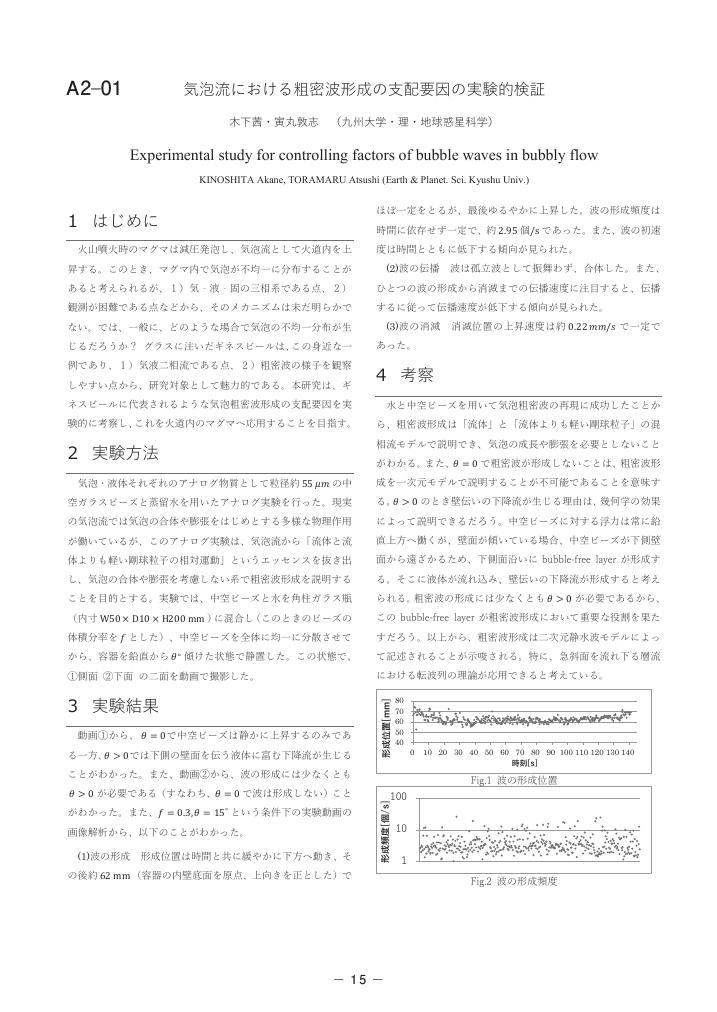- 著者
- 濱田 藍 寅丸 敦志
- 出版者
- 特定非営利活動法人 日本火山学会
- 雑誌
- 日本火山学会講演予稿集 (ISSN:24335320)
- 巻号頁・発行日
- vol.2014, 2014
- 著者
- 濱田 藍 寅丸 敦志
- 出版者
- 特定非営利活動法人 日本火山学会
- 雑誌
- 日本火山学会講演予稿集 (ISSN:24335320)
- 巻号頁・発行日
- vol.2011, 2011
7 0 0 0 OA パンと軽石
- 著者
- 寅丸 敦志 小川 裕江 大橋 正俊 増山 孝行
- 出版者
- 日本混相流学会
- 雑誌
- 混相流 (ISSN:09142843)
- 巻号頁・発行日
- vol.34, no.3, pp.403-410, 2020-09-15 (Released:2020-10-09)
- 参考文献数
- 11
Explosive volcanic eruptions produce pumice including bubbles (mainly H2O gas) which form by the vesiculation process under decompression during the magma ascent in the volcanic conduit. Shape of bubbles varies from spherical to tubular or irregular depending on the eruption style, intensity and magnitude. Interestingly, huge eruptions such as caldera-forming eruptions characteristically include elongated bubbles. We conduct the bread baking experiments to examine what controls the shape of bubbles by using the vesiculation process due to the fermentation of yeast. We use two experimental setups, baking within and without a glass conduit, to evaluate the effect of 1 dimensional expansion flow on the bubble shape. Results show that breads baked within the glass conduit typically include the elongated bubbles. We make the textural analysis for the cross section of bread after fermentation and baking with a time interval of 5 min to understand the evolution of bubble texture and with variable concentrations of yeast to evaluate the effect of amount of yeast on fermentation, consequent expansion of dough and bubble texture. By experiments with the variable concentration of yeast, it is found that the maximum expansion occurs at the certain concentration of yeast approximately 0.5 g per 50 g dough, and that the number of bubbles monotonically decreases with increasing the concentration of yeast. Time series experiments show that the number of bubbles decreases and average size of bubble increases with time for both within and without conduit. Aspect ratios of bubbles within a glass conduit are larger in smaller size of bubbles and smaller (i.e., elongated) in larger size. Numerical model simulating the evolution of bubble shape under 1 D expansion demonstrates that smaller bubbles relax to the spherical shape by surface tension effect and larger bubbles maintain the elongated shape formed by 1 D expansion.
3 0 0 0 OA P2-11 アナログ実験による曲がった柱状節理の形態の再現(ポスターセッション)
- 著者
- 濱田 藍 寅丸 敦志
- 出版者
- 特定非営利活動法人 日本火山学会
- 雑誌
- 日本火山学会講演予稿集 2014 (ISSN:24335320)
- 巻号頁・発行日
- pp.163, 2014-11-02 (Released:2017-02-10)
1 0 0 0 OA 気泡流における粗密波形成の支配要因の実験的検証
- 著者
- 木下 茜 寅丸 敦志
- 出版者
- 特定非営利活動法人 日本火山学会
- 雑誌
- 日本火山学会講演予稿集 2016 (ISSN:24335320)
- 巻号頁・発行日
- pp.15, 2016 (Released:2017-02-07)

